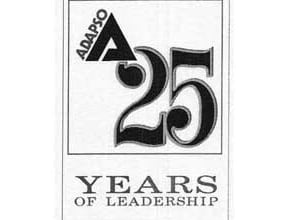
ADAPSO: Past, Present and Future
by Richard L. Crandall President and CEO
Comshare, Incorporated
Presented at ADAPSO’s 25 Year Anniversary Celebration
Scottsdale, Arizona
November 2, 1986
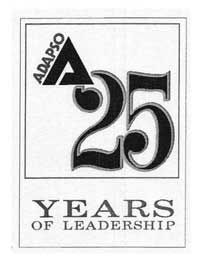
Ladies and gentlemen, good morning.
Following John Akers keynote makes me think that there are two ways to describe the congregation of executives in this room. We are either:
— The Association of Complementary IBM Market Niche Fillers, or
— The Association of Computer Services Entrepreneurs and Businessmen who have forged a $50 billion industry in 25 years by helping customers solve problems and make a profit using computers.
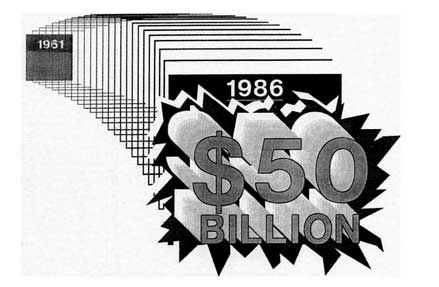
In the long run, all of us compete with IBM, even those who think they are complementary. Your own strategic plan will be better formed for assuming that. There is nothing negative in that fact – competition is healthy. Without the pressure of free and fair competition, we wouldn’t have come so far in the past 25 years.
Indeed, what better way to pause and reflect on our past and contemplate our future than to hear from the president of IBM?
Years ago there used to be IBM and the seven dwarfs with no mention of the services industry at all. Today things are different.
In rough terms, we now have three $50 billion players in the computer industry:
- The computer services industry
- IBM
- All other manufacturers
And that’s our status at the starting gate for the next 25 years.
In order to talk about those next 25 years, it’s useful to consider our history. That is the main purpose of this memorable conference. Why are we 900 executives gathered here from all corners of the information processing services industry?
Sentiment and Nostalgia …yes. Together we did it. Through all the challenges and unknowns, we have gotten to the point where everybody knows:
– Software sells hardware
– Benefits to customers come from the software and people expertise. The hardware is irrelevant except for providing reliable and cost effective MIPS as a raw ingredient for applications solution.
Sure, we the software and services industry get beat up for our hype, our buzzwords and our unpredictable product life cycles. But, we are here, alive, kicking, growing and providing what are today indispensable benefits to our customers.
We’re here for more than nostalgia and war stories.
We’re also here to take stock: To consider our origins, our successes and our failures so that we might cultivate a better insight into where and how we should go next.
ADAPSO has been the chronicler, the defender, the developer and the promoter of our industry. To see this we have only to go back over the years into ADAPSO history.
The evolution of ADAPSO goes back to the beginning of time, which for today’s purposes is 1961. It is enlightening to see the evolution of ADAPSO’s constituency, goals and strategies for they mirror the entire information processing services industry.
How could I skip quoting from ADAPSO’s very first minutes on the subject of constituency in 1961?
“Vendors operating punched cards, punched and magnetic tapes, optical readers, computers and such related pieces as may from time to time be included by the Board of Directors.” –
It took a Board decision to add a new peripheral to the list! Can you imagine how hard it was going to be to add software?
Also in those minutes we find:
“Members represented by top level executives in general or sales management.” (i.e. no lawyers, we must have known something then!)
This definition was quickly modified, although with questionable improvement, to:
“ADAPSO….comprised of companies whose interest is serving clients through data processing centers operated on the premises of the vendor.”
That certainly sounds like the beginning of time, doesn’t it?
The original ADAPSO objectives in 1961:
1. Improvement of management methods (member development)
2. Creation of high ethical and performance ideals
3. Creation of an atmosphere of general public acceptance (image)
All through the I960’s, increasingly ADAPSO became the de facto advocate of fair competition by opposing regulated entities mixing into our openly competitive and innovative industry.
In 1962-63 Bernie Goldstein took up one of the first swords against bank incursion into computer services.A few years later we engaged in the problem of public institutions reselling computer time.
In 1967 the ADAPSO minutes resolved not to allow regulated common carriers into data processing – a policy which put ADAPSO on the same track as the upstarts of the industry then – the Computer Timesharing Services Association (CTSA).
The forecasts for the timesharing industry were heady. Stanford Research Institute was sure that timesharing would certainly convert the computer industry into the next utility. No one would own a computer, and batch processing was surely dead. Here we are 20 years later and all sectors are still growing, you’d think the forecasters would give up after a while.
After a year-long mating dance, in early 1969 CTSA merged with ADAPSO. This was quite an important event, since it marked not only a step function in growth for ADAPSO but an early ad-hoc organizational strategy that would later be formalized for accommodating the future diversity of the industry. I am referring to the sectional approach on which I’ll comment later.
So, CTSA became CTSS and ADAPSO’s concerns officially expanded to include the following:
1. Computer manufacturers’ use of timesharing as a loss leader.
2. Regulated telephone monopolies mixing in EDP services.
3. FCC and regulatory trends.
By 1971 a reduced lot of more mature timesharers were pulling out of the devastating recession of 1970-71. The new upstarts were the software companies who had formed their own group – the Software Industry Association (SIA). The seeds of change were planted again.
In that year, SIA merged with ADAPSO in a marriage that was initially like oil and water – the only way you could keep them mixed together was to keep shaking. At first the combination was pushed by a few visionaries. It was like a Jewish matchmaking – you know, “don’t worry; you’ll learn to love each other later.”
1972
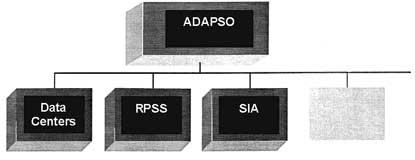
Without getting into a lot of detail, a few highlights in the 1970’s will underscore ADAPSO’s increasing success in representing its constituency.
In 1972 CTSS had successfully stopped enough ISAL tariffs on a state-by-state basis to kill off the entire trend. These Information Service Access Line tariffs were a Bell plot to discriminate economically against telephone lines connected to computers. They played the numbers game and attacked state by state, but ADAPSO is more effective than any single member. I was personally quite involved with that cause, and I remember the elation as we won. It was clearly an activity no one company could take on by itself.
In 1973:
- SIA was concentrating its efforts on the IBM anti-trust case.
- Data Centers were focused on self-development.
- CTSS was gloating over another very important win – a Court of Appeals decision supporting maximum separation in the telephone industry.
The principles of maximum separation, forged in dealing with the telecommunications common carriers, was to become a major strategy in our broadened pursuit of fair competition.
In the middle 1970’s we were an emerging industry, and we were being hit on all sides:
– Government provided EDP services
– State sales taxation
— FCC computer inquiries
— Software protection problems
— Accounting treatment issues
— Interface problems with IBM
— General confusion in the public and in the marketplace, particularly regarding software products
ADAPSO needed a plan, a set of strategies, priorities and organization to accommodate its diversity, and to prepare it for even faster paced change in the future. In 1977 formal planning commenced and in 1978 ADAPSO’s first explicitly stated long-range plan was prepared and approved by the Board.
I’ll never forget 1978. It was the year I was elected president of ADAPSO, and I soon learned that it was going to be an exercise in how to run Comshare without being there. I’ll bet George Raymond knows what I mean.
Consider that it was 1978 in which:
- John Imlay (then next in line for the ADAPSO presidency) and I decided we would do a two-year, back-to-back assault on the major business publications in an attempt to convince them that our industry was worth independent and continuous coverage.
- International non-tariff trade barriers became a major issue. I found myself being accused by the Canadian press of single-handedly declaring war against the Canadian Foreign Investment Revenue Agency.In June we had our first ever international Congress in Barcelona.
- Then there was the first long-range planning effort culminating in Board approval in October of that year.
- If that wasn’t enough, 1978 was the year we moved ADAPSO from New Jersey to Washington D.C.
- To top it off, Imlay had me jumping out of a magician’s crate in a Superman outfit – blue tights, red cape and all – as “ADAPSOMAN”, defender of the industry. That was right here in Arizona.
But, back to the strategic plan. It represents an important piece of history.
Its first time span was 1978-1985.
ADAPSO’s modernized purpose was:
“Maximize the benefits of computer- services to end users throughout the world by fostering the health, prosperity and competitive nature of member companies”.
What were the high priority goals?
- Ensure the free enterprise nature of the industry by enforcing the intent of the laws regarding fair competition.
- Eliminate legislative and regulatory discrimination impacting
the industry. - Image
a) majority of surveyed users will acknowledge the true values offered by software/services firms.
b) financial community coverage of software/services as an industry separate from hardware.
c) achieve recognition of software as a financeable entity. - Establish positive attitude towards employment in the industry.
- ADAPSO recognized as an authority on industry data.
- ADAPSO’s members represent 70% of industry revenue and will grow in membership to 700 firms.
During the past seven or eight years that these goals have been operative, Adapso has blossomed into an organization of many accomplishments. It has also grown to reflect the changing structure of the industry. In 1982 the organization expanded by several more sections to officially accommodate Professional Services, Microcomputer Software (another acquisition, this one fathered by Don Devine) and Integrated Systems.
1982
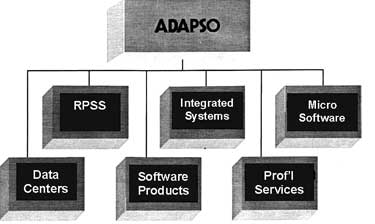
It is interesting to see that over the years, the top three goals have remained in tact and of identical priority.
The new goals of high priority have been:
#7 Software protection trade secret and copyright protection will he adequately afforded to software; loss due to software piracy will be reduced to under 10% of industry revenue.
#8 ADAPSO’s leverage with IBM – More than 50% of IBM alternate channel revenue will be represented by ADAPSO.
#9 Every important international market will evidence no greater barriers to computer software and services trade than exists in the U.S. for foreign entrants.
The addition of the “IBM leverage” goal motivated the repackaging of the Integrated Systems section to be the Value Added Reseller (VAR) section.
At this point, I could give a blow by blow description of all the events leading up to the present, but I’d really have you squirming in your seats if I attempted to he comprehensive.
Instead, I’m going to follow the line of one of the trade publications. While assembling interviews for their coverage of this event, they asked me: How has ADAPSO performed for its members? How do we fill out the report card?
That’s a tough question to ask of an entity that is as loose as a trade association where some of its goals are lofty and long term. But the question deserved an answer, and so I responded:
Let’s use our original goals and score them:
REPORT CARD – on original goals
Grade
B : Fair Competition – Were doing well here. We have maximum separation implemented in the important regulated areas. The fight is not over by any means. We’re particularly concerned with CPA firms, Bell operating companies and the ever present specter of IBM.
B+ : Fair Regulation – We’ve had a number of wins in taxation, telecommunications and software protection. We remain an unregulated industry, although we’ve got to keep an eye on things like privacy and warranty. Education is the major task ahead of us.
A+ : Image – Our image campaign has been second to none, particularly given the complexity of the subject. We
have utilized our image effort not only for public relations, but for educational purposes as well.
A : Positive attitude towards employment – Everyone knows that if you are going to be a d.p. professional, its more fun to work for a software/services firm.
C : ADAPSO – Authoritative source of data. I suppose we are as authoritative as they come, but this area is in bad shape. There’s little reliable industry data, certainly nothing beyond sales volume and employment.
| A+ Membership: | 1985 | |
| Goal | Actual | |
| # Members | 700 | 772 |
| % of Industry | 70% | 60% |
With some goals I can prove cause and effect, and in some cases I can’t. But, events don’t happen by accident. As a close observer, I would say that there is overwhelming evidence that we would be far worse off today if there hadn’t been an ADAPSO.
An excellent example of the necessity of the existence of our trade association comes from the Office of Technology Assessment or OTA. A year and a half ago ADAPSO suggested my appointment to the 21 member advisory hoard for OTA’s efforts in assessing international competition in the services industry. You can be sure that as a representative of our industry, I’ve been promoting our position and communicating our fundamentals.
I’ve long been an advocate that this country needs to be awakened to the importance of software and services to the infrastructure and productivity of our entire national economy. Authoritative, economically based studies that quantify, prove and educate our importance are invaluable in public sector education in pursuit of our advocacy goals.
One element of OTA’s findings has been officially released in a special report called “Trade in Services, Exports and Foreign Revenues”, September 1986. Listen to some of its conclusions:
“OTA’s estimates indicate that Federal Government balance of payments figures significantly understate both exports and imports of services”. As much as half of the nation’s exports of services may escape the official statistics.”
“The causes…data categories that are conceptually flawed or outdated. For example, the nation’s trade statistics make no explicit provision for computer software, one of the most critical service-related products in a high-technology economy”,
In that same report, ADAPSO is quoted often. I can tell you that the attitudes of my colleagues on the OTA Board changed a lot from the beginning of these sessions to the end. Out of a total worldwide estimate of $30 billion in software sales in 1985, U.S. suppliers accounted for $21 billion. This is an industry that was “Made in America” and must remain part of America’s strength.
Computer Software Industry
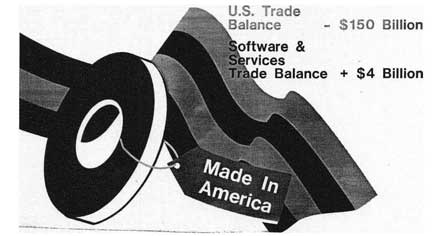
For the first time, OTA attempted a quantification of the impact of software and services on the U.S. balance of payments problem: In 1984 when our total deficit was $150 billion, software and services produced a $4 billion positive annual surplus and that’s $4 billion out of $14 billion produced by the entire services industries including banks, construction, legal, accounting – the lot!
Back to finish the report card, let’s score the three newer goals I mentioned that were added in the past four years. We’ve had less time to perform under these goals, but still we should forecast a grade:
B+
7. Open International Markets.
I think we’ve already seen great progress, certainly in Canada and Japan. We’ve got momentum and attention –I believe we’ll continue to progress forward with reducing trade barriers.
8. IBM’s impact on industry structure and competiveness
I really can’t grade this one. I’d say our score today is a C at best. Last year we initiated very high level discussions between the executive level of IBM, including John Akers and a special Adapso Board committee consisting of Art Kremer, Dave Eskra, myself and the current chairman of Adapso.
We see some signs of possible beneficial movement on critical issues that concern us, and I definitely believe that IBM is more aware of what potential actions could cause potential problems. Whether we make provable progress will have to be judged after the fact.
9. Software Protection
We’ve done a great job in the U.S. with our “Thou Shalt Not Dupe” promotional campaign that went to over 750,000 people directly and was covered in 350 publications. There is no question that tremendous progress has been made in reducing piracy and increasing corporate awareness of the illegality of duping. The evidence mounts — including in part the recent trend towards elimination of copy protection by most micro-computer software products vendors.
Why only a B+? We haven’t really tackled the rest of the world yet — truly an awesome challenge.
Our report card speaks well of what we’ve accomplished in 25 years and where we stand at the moment, but how about the future?
Adapso and the Future of the Industry
As we look forward, we have an even greater challenge than anything we’ve had to face before.
- More difficult than getting IBM software unbundled from hardware.
- More difficult than overcoming all the legislative and regulatory anomalies about software and computer services.
- More difficult than overcoming the old Bell System’s early opposition to connecting telephone lines to computers.
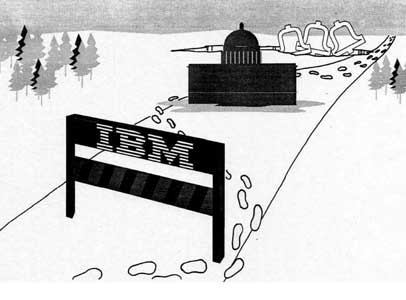
- More difficult than navigating through four recessions in the past couple of decades.
- More difficult than getting software to be comprehended and valued properly in the market and in the public and financial sectors.
In a word, the challenge is integration. The deliverable is the provision of real benefits in the form of increased profits and productivity to our customers.
If our industry doesn’t start taking responsibility for delivering solutions rather than uncoordinated technologies, not only will we falter, but so will our economy.
The dawning of that realization is only recently beginning to show up in authoritative speeches and in the press. In a recent Computerworld article entitled “Holding Out for Systems Integration”, we read:
“Most MIS shops have a variety of equipment from different vendors running incompatible applications and operating systems.
MIS movement toward more centralized control of acquisitions, coupled with the establishment of corporate-wide criteria for connectivity and compatibility has lengthened sales cycles and placed the burden of integration support on the vendor”.
Why is the challenge so big? After all, we’re still as clever as we’ve always been, and even a bit more experienced. There’s certainly no lack of technology and tools.
The problem lies in the very nature of our free enterprise system. With our freedoms we foster innovations, intuitive leaps and surprises. We thrust these upon the world hero style, just like the way America was formed. But with all its excitement and progress, the system has some defects to overcome. No one is forced to work with each other and everyone can re-invent the wheel as much as they want. Don’t get me wrong, I’d be the last to suggest we abandon free enterprise in order to meet this challenge. In fact, we must rigorously oppose governmental regulations, private sector monopolies and other anti-competitive possibilities.
The market is our regulator and d.p. purchasers are resetting some of the adjustments. In fact, there are new purchasers on the scene and they are coming from the ranks of the end users who care little about generic check lists and more about benefits. The slump of ‘85 was a warning that continued growth is going to have to be earned by delivering completed solutions.
How can ADAPSO help its members deal with this new market force demanding integration and solutions? What would be appropriate for ADAPSO’s role?
a) Member information interchange – a major use of ADAPSO by its members is to pick up on new ideas about how others are dealing with new issues and market forces; interchange is best with high level and CEO involvement in ADAPSO. They are the strategists in most companies.
b) Standards are an inevitable part of the solution to integration. While this has not been an active area for ADAPSO, a trade association is the best forum.
c) Complementary relationships will increase in frequency – development and marketing relationships will be used to assemble broad interconnected product lines. ADAPSO is a fertile ground for new relationships and it can also help reduce some of the artificial barriers such as contracting standards and legal problems in this area.
d) While we have been ineffective as yet at gaining a workable relationship between our industry and IBM regarding advance release of interface information, success of this effort is critical to integration. ADAPSO is still the best instrument for spearheading the effort with IBM.
So the market demand for vendor initiated integration presents great challenges and great opportunities. Furthermore, ADAPSO has important new roles to fulfill in helping us each to meet the challenge.
This is an industry celebration and, more specifically, it is an ADAPSO celebration. I’ll close my comments by recalling our survey of why companies are members of ADAPSO.
ADAPSO: Helping to Accommodate Change as we Approach the Future
Learn From Peers: acquire knowledge of other company strategies, methods of doing business using different delivery means, new marketing techniques, new product availability, trends in alternate distribution channels, etc.
ADAPSO is a strong, resourceful vehicle for concerted collective action on specific issues of industry-wide importance.
ADAPSO helps improve market receptivity to and awareness of our primary values via its professional image and lobbying efforts.
ADAPSO is the best place to collectively strategize how to deal with the growing uncertainty about IBM’s impact on the industry.
I can vouch for these reasons for membership with a very personal closing story.
You all know Comshare as one of the very early timesharing vendors. It is no secret that as the 1970’s drew to a close, our fortunes slowed along with the general reduction in attractiveness of timesharing services in the market.
After our management convinced itself that the downturn was not just the weak economy of 1980, we were able to see the market changing strongly in favor of software products for in-house use.
But I didn’t understand some of the important fundamentals of the software products business. I couldn’t see how to make a profit because I didn’t know about add-ons, maintenance fees, multiple copy opportunities and unbundled professional services charges. I wasn’t about to put Comshare through the wrenching multi-year process of changing long range strategies without understanding the business we would be heading toward.
I learned those fundamentals at ADAPSO. At meetings, in the bar, at dinners – anywhere I could corner a CEO of an established software company I did. And I learned what I needed to know. It gave me the confidence to embark on a path which is now returning my company to growth and profitability. We are much better equipped to deal with the complex pattern of market demand.
Without ADAPSO, Comshare would have started the process too late, or not at all. Now how do you put a number on a benefit of that magnitude?


